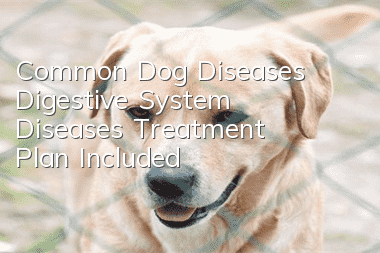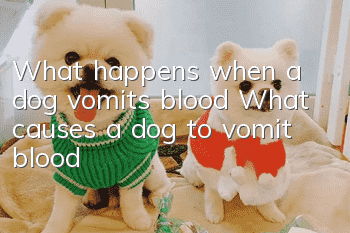Common Dog Diseases Digestive System Diseases (Treatment Plan Included)

Dog stomatitis
Causes: foreign bodies (such as fish bones, bones, etc.), food that is too cold or hot, chemical substances (such as licking corrosive drugs, etc.), old dog teeth and various pathogenic microorganisms ( Such as viruses, necrotrophic bacteria), infectious diseases such as canine distemper, etc. can be caused.Symptoms: Refusal to eat or chew carefully due to oral pain; hard objects are often spit out from the mouth, excessive salivation, flushing of the oral mucosa, high temperature, bad breath, and heavy tongue coating. In vesicular stomatitis, there are blisters on the oral mucosa, which are filled with serous fluid; when the blisters burst, bright red erosions or ulcers appear. When suffering from ulcerative stomatitis, dark red bleeding, swelling, tissue necrosis and falling off of the gums of the incisors and canines form ulcers, and the teeth become loose; ulcers also occur on the lips and cheeks corresponding to the disease. Bad breath and difficulty chewing.
Treatment: Rinse the mouth with 0.1% potassium permanganate solution, 2% potassium chlorate solution or 2% alum solution. Apply iodine glycerin or 1% sulfa-glycerol suspension to the ulcer surface. For chronic stomatitis, 1%-5% protein silver and the traditional Chinese medicine Bingboran Powder are also very effective.
Canine tonsillitis
Mainly caused by eating snow, drinking ice water, sudden changes in temperature, and bacterial infections, such as Streptococcus, Pasteurella, and Clostridium weilinii type A Bacteria etc. Some people think that tonsil lesions can cause nephritis and arthritis, so when you suffer from other chronic and recurring diseases, you should pay attention to checking the tonsils.
Symptoms: Acute tonsillitis mostly occurs in dogs aged 1 to 3 years old, with fever (41°C), anorexia, yawning, and coughing caused by gentle pressure on the throat. Oral examination revealed red and swollen tonsils, foamy mucus, and even ulcers.
Treatment: Treat with sulfa or antibiotics and apply iodine glycerin (1 part iodine, 3 parts potassium iodide and 30 parts glycerin) locally.
Canine Pharyngitis
Refers to inflammation of the oral cavity and pharyngeal mucosa
The causes are the same as gastritis and larynx inflammation, often secondary to tonsillitis. Symptoms and treatment are the same as tonsillitis.
Canine esophageal obstruction
mostly occurs behind the pharyngeal cavity or before the entrance to the chest cavity.
Symptoms: Incomplete obstruction, retching and choking movements, slow food intake, careful swallowing. Complete obstruction results in refusal to eat, restlessness, straightening of the head and neck, excessive salivation, scratching of the neck, and evenasphyxia.
Diagnosis: Diagnosis can be based on medical history and characteristic symptoms, or by X-ray or esophageal exploration. If it is stuck in the esophagus of the neck, it can be removed from the outside.
Treatment: If the foreign body is not too big and smooth, you can push it up and down or push it back into the mouth or introduce it into the stomach; if the foreign body is large, has sharp edges and corners, and is stuck, Even if there is a perforation, it must be surgically removed. If it is fruit, food bolus or even tubers, wait for it to soften on its own, and then allow the foreign object to slide into the stomach after an accidental choking movement.
Foreign bodies (such as bones, sticks, needles, etc.) can also penetrate into the cheek, hard palate, and even the pharynx, causing food refusal, salivation, head shaking, and scratching of the mouth and face with claws.
Treatment: Open the mouth for inspection and remove the foreign body.
Canine gastritis
Cause: mold. Rotten food, overcooled feed, indigestible substances, irritating drugs (drugs for treating skin diseases or rat poison), and even sudden changes in weather can cause it. Certain infectious diseases such as canine distemper, canine hepatitis, leptospirosis and certain parasites (entering the stomach from the intestines) can cause gastritis.
Treatment: Stop vomiting and give easy-to-digest thin food. Clear the gastrointestinal tract through an enema or with 20-50 ml of castor or paraffin oil. In order to stimulate gastric juice secretion and increase appetite in chronic gastritis, dilute hydrochloric acid can be taken three times a day, 0.2-1 ml each time. Tincture of bitters, tincture of gentian, or pepsin may also be used.
Canine gastric dilation
Symptoms: indifferent expression, restlessness, moaning, belching, rapid breathing, and abdominal distension. In severe cases, it can cause suffocation. In chronic gastric distension, a full stomach can be felt behind the ribs; in fasting, there is a drum sound upon percussion, and after eating, there is a dull sound, indicating indigestion.
Treatment: Use a gastric tube to guide the stomach, or subcutaneously inject apomorphine (0.001-0.005g) or carbachol (0.001g/25kg) to induce vomiting. If the foreign body in the stomach cannot be eliminated, it should be removed surgically.
Canine liver cirrhosis
Liver cirrhosis refers to the proliferation of a large amount of connective tissue after liver tissue damage, making the organ hardened. The disease is a chronic process that often occurs in older dogs.Causes and occurrences: Chronic poisoning, hepatitis, and malnutrition will cause varying degrees of liver tissue damage, which will be replaced by connective tissue hyperplasia; liver leeches cause chronic cholangitis by parasitizing in the bile ducts, causing connective tissue hyperplasia around the bile ducts. , resulting in cirrhosis of the liver.
Symptoms: loss of appetite, easy fatigue; nausea, vomiting, indigestion or diarrhea. In severe cirrhosis, there are ascites, bleeding diathesis, hepatomegaly and splenomegaly, hypoalbuminemia, portal hypertension and other phenomena. Clinically, it is determined by liver function tests (elevated transaminases).
Treatment: Remove the cause of the disease and treat symptoms. Inject 5-10 ml of 40% glucose intravenously to increase glycogen storage in liver tissue. Amino acids such as methionine and cysteine have lipophilic functions and can protect the liver. Give large doses of vitamin B complex and vitamin C. The application of glucocorticoids is also effective.
Random articles
- What are the common intestinal parasites in dogs? How much do you know?
- How to train a Border Collie to walk? A few steps to teach you!
- How to train a pet dog to understand human speech? Come and take a look!
- How to train a dog to be a police dog? The dog’s performance is unexpected!
- Prevention and treatment of common summer diseases in German Shepherds!
- Why do dogs have bloody stools? Several common reasons why dogs have loose stools and bloody stools!
- Which of the dog’s private behaviors are normal and which are abnormal?
- How to train Eurasian dogs to be obedient
- What medicine is better for dogs with suppurated skin?
- Pets keep scratching their mouths, beware of foreign objects stuck in the esophagus



